International Journal of Geosciences
Vol.5 No.4(2014), Article ID:45383,18 pages DOI:10.4236/ijg.2014.54041
Calcareous Nannofossil Biostratigraphy and Stage Boundaries of the Santonian-Eocene Successions in Wadi El Mizeira Northeastern Sinai, Egypt
Hamza Khalil1, Esam Zahran2
1Geology Department, Faculty of Science, Tanta University, Tanta, Egypt
2Geology Department, Faculty of Science, Damanhour University, Damanhour, Egypt
Email: hamzakhalil2002@yahoo.com
Copyright © 2014 by authors and Scientific Research Publishing Inc.
This work is licensed under the Creative Commons Attribution International License (CC BY).
http://creativecommons.org/licenses/by/4.0/


Received 13 February 2014; revised 15 March 2014; accepted 11 April 2014
Abstract
The stratigraphic successions exposed in Wadi El Mizeira have been dated through the analysis of the calcareous nannofossil assemblages. The results of this study indicate that the successions comprise the Santonian-Late Maastrichtian (Sudr Formation), the Paleocene (Esna Formation) and the Early Eocene (Thebes Formation). The following biozones were recognized: Late Santonian, CC16 Zone; Late Santonian/Early Campanian, CC17 Zone; Early Campanian, Aspidolithus parcus Zone (CC18) Zone; Late Maastrichtian, CC25c Zone; Early Paleocene (Late Danian), NP3 Zone and NP4 Zone; Late Paleocene (Thanethian-Selandian), NP5 Zone; Early Eocene, NP9b Zone, NP10a Zone, NP11 Zone, NP12 Zone and NP14 Zone. Several stratigraphic hiatus were recorded in the studied interval including the absence of Cretaceous nannofossil Zones CC19 to CC25b and CC26 as well as the early Paleocene Zones NP1 and NP2 and probably the basal part of Zone NP3, in addition to the absence of the Zones NP6 and NP7/8. These hiatus may be attributed to environmental conditions, structural activity and/or post depositional processes. This work represents the first attempt to evaluate the nannofossil taxa of the Wadi El Mizeira, Northeastern Sinai.
Keywords
Calcareous Nannofossil, Biostratigraphy, Santonian, Eocene, Sinai, Egypt

1. Introduction
The Upper Cretaceous-Lower Paleogene sediments are well developed in the stratigraphic successions of Sinai. A relatively thick Santonian-Eocene sequence was measured and sampled from Wadi El Mizeira, Northeastern Sinai (Figure 1). Wadi El Mizeira (about 35 km south of El Qussaima) extends to the north and west around Gabal Araif El-Naqa. The Upper Cretaceous Sudr Chalk is exposed forming the floor of the wadi and the footslope of Senaf El Mizeira ridge, while, the Thebes Formation forming the prominent cliff of Senaf El Mizeira Ridge.
The paleontological aspects of the Upper Cretaceous-Lower Paleogene in north east Sinai have been the subject of several studies [1] -[31] because of its relative richness in microfossils and expanded stratigraphic records. The published data on the calcareous nannofossil biostratigraphy in northeastern Sinai are scarce. The purpose of the present study is to establish a calcareous nannofossil biostratigraphic framework and define the stage boundaries and biostratigraphic hiatus for the Santonian-Early Eocene sediments at Wadi El Mizeira.
2. Material and Methods
Calcareous nannofossil analyses have been performed for 129 samples taken on average every 1 m; with high resolution sampling adopted close to key biohorizons. Calcareous nannofossils are generally abundant and well diversified in the studied sequence, with a good degree of preservation.
Samples were processed by smear slide preparation from raw sediment samples [32] . All samples were prepared similarly to insure uniformity in the distribution and to minimize bias. Relative species abundances were determined by counting a population of at least 300 specimens along a random traverse with a light microscope at a magnification of about 1250×. Rare species were searched in two additional traverses across the slide to assure that no stratigraphic marker was overlooked. Total nannofossil abundance was calculated as the total number of specimens counted per number of fields of view (FOV) traversed.
Preservation was estimated as Good (G) for nannofossil specimens exhibiting little or no dissolution; Moderate (M) for moderate dissolution and/or overgrowth and Poor (P) for strong dissolution and/or over growth. A fully referenced taxonomic listing appears in [33] . The stratigraphic distribution, preservation and abundance of the nannofossils are provided in a distribution charts (Figures 3-5).
3. Lithostratigraphy
The Santonian-Eocene succession exposed at Wadi Mizeira is generally composed of carbonate sediments. Lithostratigraphically, the succession is subdivided from base to top into; the Sudr, the Esna and the Thebes Formations (Figure 2).
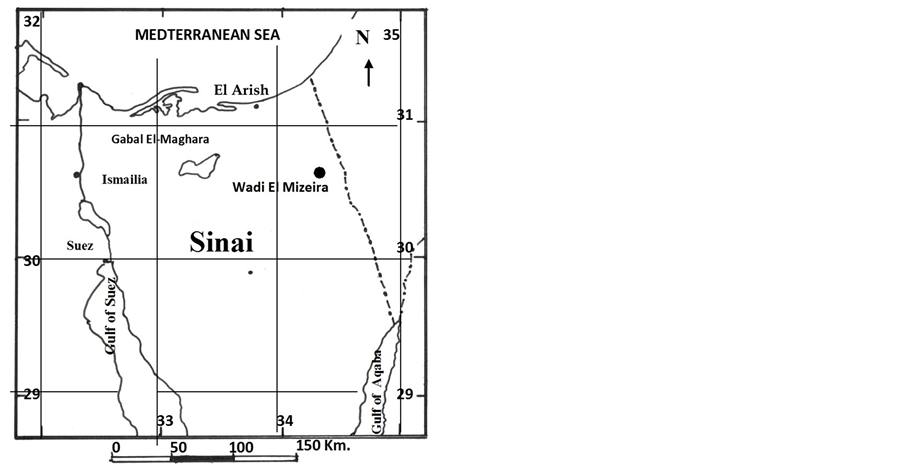
Figure 1. Location map of Wadi El Mizeira, Northeastern Sinai.
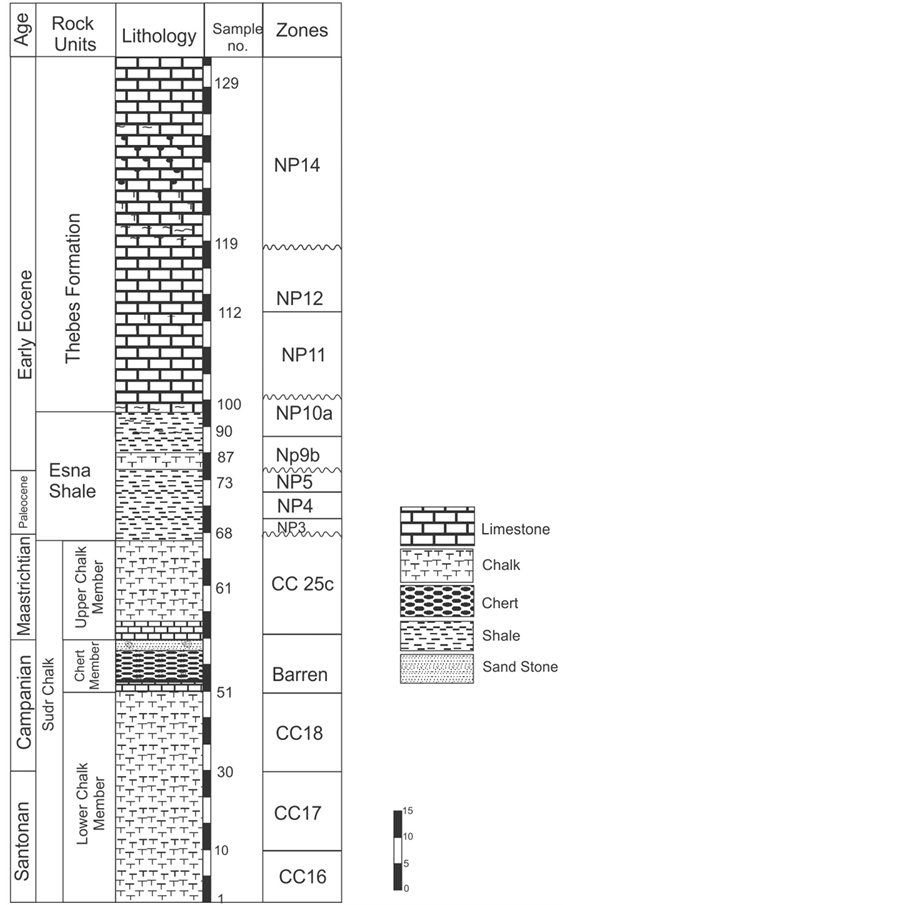
Figure 2. Lithoand calcareous nannofossil biostratigraphy of the Santonian-Eocene succession in Wadi El Mizeira, Sinai.
3.1. Sudr Formation
The term Sudr Chalk was originally introduced by [34] for the chalky limestone succession exposed at Wadi Sudr, west central Sinai. In the present study the Sudr Formation is exposed along the floor of Wadi El Mizeira and the foot-slope of Senaf El Mizeira Ridge. It is predominantly composed of chalk, chalky limestone with shale intercalations, siliceous limestone, chert and bioclastics. The Sudr Chalk could be subdivided into; the Lower Chalk Member, the Chert Member and the Upper Chalk Member.
The Lower Chalk Member attains a thickness of about 35 m and consists mainly of hemipelagic soft snowwhite massive chalk. The middle Chert Member exhibits distinctive lithologic characters and is composed of dark chert, siliceous limestone, siliceous sandstone and bioclasts. It attains about 10 m thick and contains few phosphatic beds and oyster banks. The Upper Chalk Member (about 18 m thick) is composed of chalk and chalky limestone grads into argillaceous chalk at the top. The calcareous nannofossil content assigned the Lower Chalk Member to Santonian-Early Campanian age and the Upper Chalk Member to Late Maastrichtian age. The stratigraphic position of the Middle Chert Member points to Late Campanian - Early Maastrichtian age.
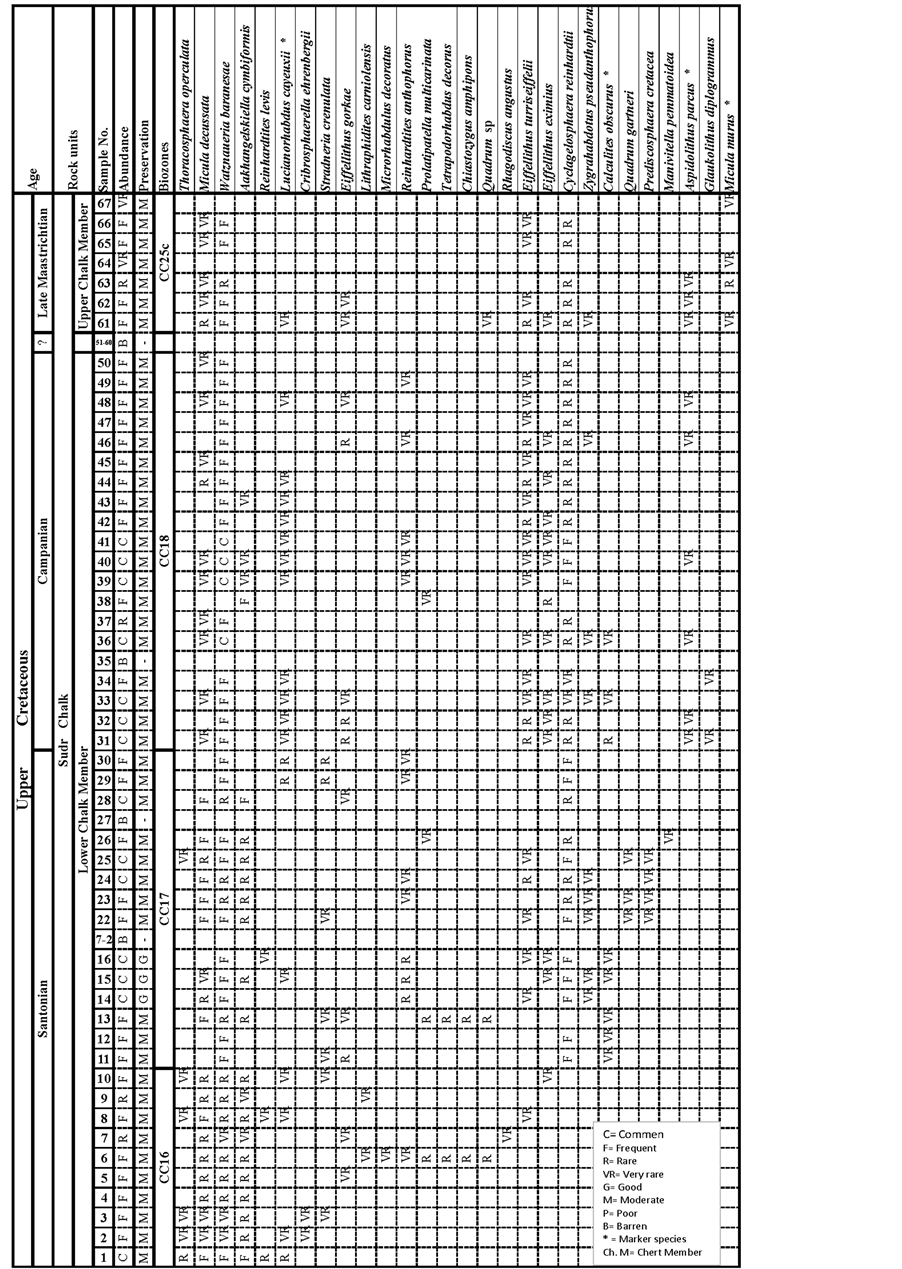
Figure 3. Distribution, abundance, preservation and biozones of the Santonian-Maastrichtian calcareous nannofossils in Wadi El Mizeira, Sinai.
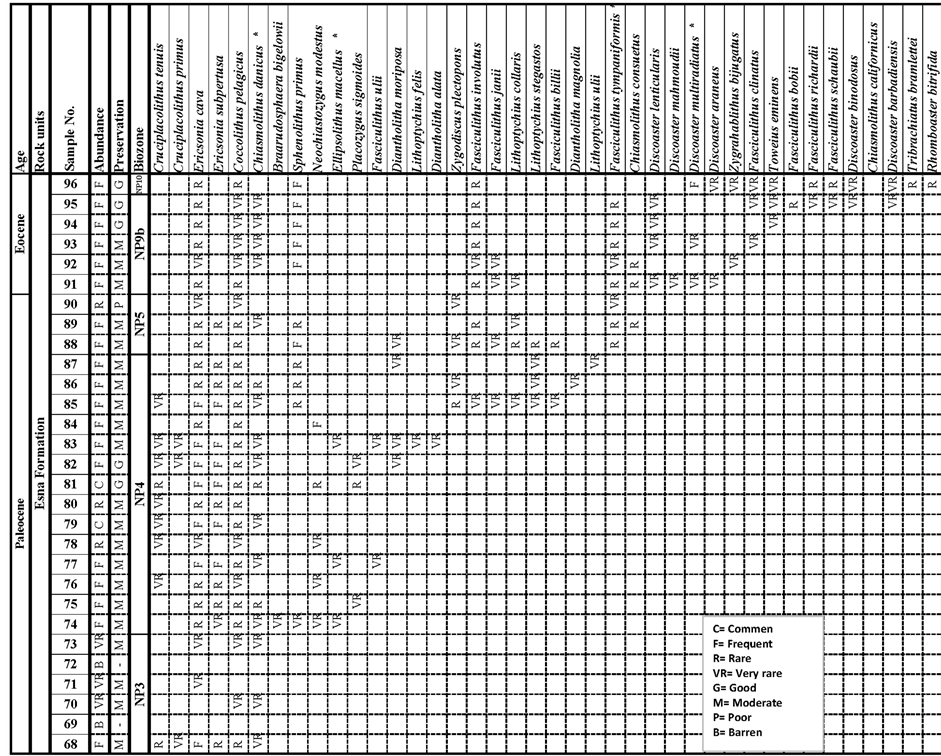
Figure 4. Distribution, abundance, preservation and biozones of the Paleocene-Eocene calcareous nannofossils in Wadi El Mizeira, Sinai.
3.2. Esna Shale
The term Esna Shale was first introduced by [35] . In the study area the Esna Formation (24 m thick) overlies the Upper Cretaceous Sudr Chalk and underlies the Lower Eocene Thebes Formation. At Wadi El Mizeira, the Esna Shale is predominantly composed of greenish gray shale, along Senaf El Mizeira Ridge the formation displays significant change in lithology and is made up of greenish hemipelagic marls, chalky with few grayish green shale intercalations in the middle part. The calcareous nannofossil content points to Late Maastrichtian to Early Eocene age for the Esna Shale.
3.3. Thebes Formation
The term Thebes Formation has been introduced by [36] to describe the limestone unit with chert bands overlying the Esna Shale in many parts of Egypt. At Wadi El Mizeira the Thebes Formation is well exposed forming the prominent cliff of Senaf El Mizeira Ridge. It is 65 m thick and composes of marls, marly chalk, and chalky limestone with chert bands and nodules. The formation exhibits lateral lithologic change and dominates with white chalk, siliceous limestone and some shale. The nannofossils content indicates an Early Eocene age for the Thebes Formation.
4. Biostratigraphy
In the present study, nannofossil biostratigraphic framework is applied according to the biozonation scheme of
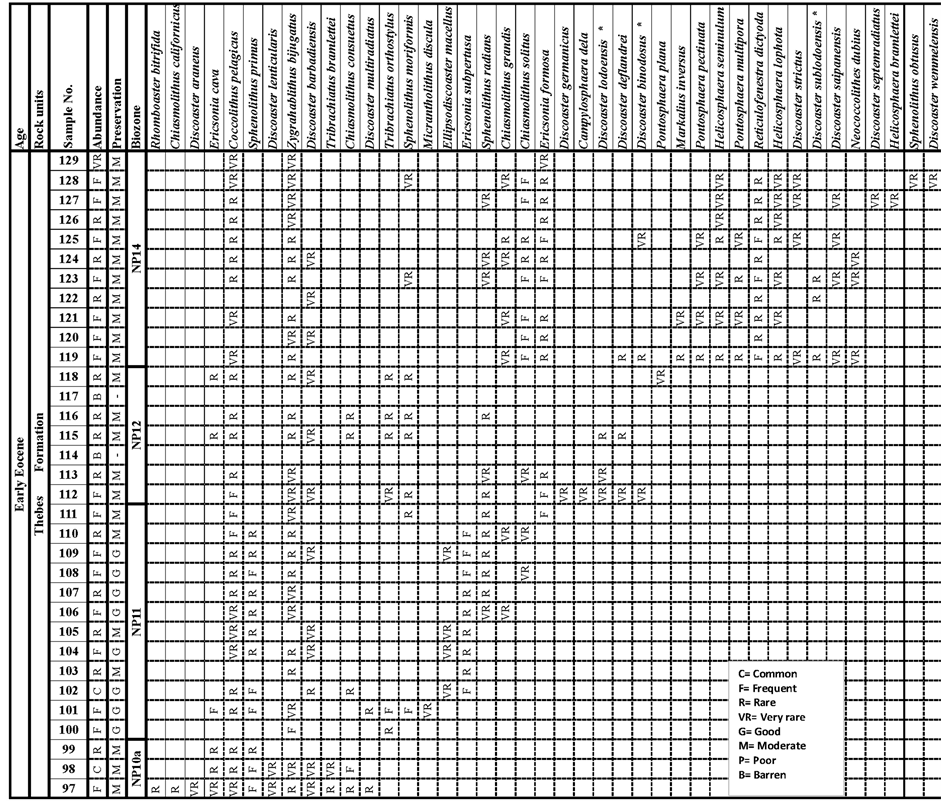
Figure 5. Distribution, abundance, preservation and biozones of the Eocene calcareous nannofossils in Wadi El Mizeira, Sinai.
[37] [38] for the late Cretaceous and Early Eocene, respectively. A total of 109 nannofossil species were identified from the Upper Maastrichtian, Paleocene and Lower Eocene rocks of the studied section. Their stratigraphic distributions are shown on Figures 3-5 and some representative calcareous nannofossil species are illustrated in Plates 1-3. Biostratigraphic subdivisions in the study area based on the calcareous nannofossils have been established and correlated with the standard biozones recognized in Egypt (Table 1 and Table 2) and other parts of the world.
Twelve nannofossil zones are identified in the studied area (Santonian to Early Eocene), based on the first and last occurrences (FOs, LOs) of the marker species. The Upper Cretaceous rocks comprise CC16, CC17, CC18 and CC25c. The Lower Paleogene rocks comprise eight zones from NP3, NP4, NP5, NP9b, NP10a, NP11, NP12 and NP14. The recognized biozones and subzones and the correlation between them are discussed below.
5. Late Cretaceous Biozones
5.1. Lucianorhabdus cayeuxii Zone (CC16)
Definition: Interval from the FO of L. cayeuxii Deflandre to the FO of Calculites obscurus (Deflandre).
Author: [37] .
Age: Late Santonian.
Thickness: 10 m; equivalent to the lower part of the Lower Chalk Member.
Table 1. Correlation of Santonian-Maastrichtian calcareous nannofossil biostratigraphy of Wadi El Mizeira section with other biostratigraphic schemes in Sinai and Western Desert.
Table 2. Correlation of Paleocene-Eocene calcareous nannofossil biostratigraphy of Wadi El Mizeira section with other biostratigraphic schemes in Sinai.
Assemblage: In general, the identified taxa in this zone are rare, but diversity is relatively high. In addition to the nominate taxon, this interval includes W. béarnaise and Q. Gartner among many other species.
Remarks: The first occurrence of L. cayeuxii is a very reliable event. Zone CC16 is equivalent to the upper part of Zone UC11 and the UC12-13 zones of [39] .
5.2. Calculites obscurus Zone (CC17)
Definition: This zone covers the interval from the FO of Calculites obscurus to the FO of Aspidolithus parcus.
Author: [37] .
Age: Late Santonian/Early Campanian.
Thickness: 10 m; equivalent to the middle part of the Lower Chalk Member.
Assemblage: The assemblage of this interval is similar to that of the underlying CC16 Zone, with the addition of rare occurrences of the nominate taxon.
Remarks: According to [39] , the first occurrence of Arkhangelskiella cymbiformis defines the base of Subzone UC13a of Early Campanian age. In the present study, rare specimens of A. cymbiformis have been observed in the Late Santonian (CC17), indicating that the range of the A. cymbiformis extends down into the Santonian. The FO of Aspidolithus parcus is an event that has been used for zonation and coincides reasonably well with the Santonian/Campanian boundary.
5.3. Aspidolithus parcus Zone (CC18)
Definition: Interval from the FO of Aspidolithus parcus to the LO of Marthasterites furactus.
Author: [37] .
Age: Early Campanian.
Thickness: 15 m; equivalent to the upper part of the Lower Chalk Member.
Assemblage: Similar to the nannofossil assemblage from the CC17 Zone, with the addition of the nominate taxon Aspidolithus parcus.
Remarks: The upper boundary of the CC18 not well defined due to the absence of M. furactus. The first occurrence of B. parcaparca is a reliable global stratigraphic datum. Numerous workers have indicated that this datum marks the base of the CC18 Zone and serves as an approximation to the Santonian/Campanian boundary [16] [39] -[46] . The current study maintains this approximation because it can be correlated globally at all palaeolatitudes and in all palaeobiogeographical provinces [39] [46] .
5.4. Micula murus Zone (CC25c)
Definition: It is defined as the interval from the FO of Micula murus to the FO of N. frequens.
Authors: [47] , emended [48] .
Age: Late Maastrichtian.
Thickness: 18 m; equivalent to the upper part of the Lower Chalk Member and the lower most part of the Esna Formation.
Assemblage: Besides the marker species, this zone is dominated by Micula decussata, Watznaueria barnesae, Thoracosphaera operculata, Prediscosphaera cretacea, Eiffellithus gorkae, Arkhangelskiella cymbiformis, Eiffellithus turrisieffelii and Cyclagelosphaera reinhardtii.
Remarks: In this study, this zone is identified from the first occurrence (FO) of Miculamurusto the FO of N. frequens. This zone correlates with the lower part of the Nephrolithus frequens Zone [49] modified by [50] . The M. murus Zone is probably restricted to low latitudes [50] . The top of CC25c is not defined accurately due to the absence of M. prinsii.
6. Paleocene and Eocene Biozones
6.1. Chiasmolithus danicus Zone (NP3)
Definition: FO of Chiasmolithus danicus to FO of Ellipsolithus macellus.
Author: [51] .
Age: Early Paleocene (Late Danian).
Thickness: 2 m; equivalent to the lower part of the Esna Formation.
Assemblage: It is dominated besides the marker species by Ericsonia cava and relatively rare to very rare occurrences of Cruciplacolithus primus, Coccolithus pelagicus and Thoracosphaera operculata.
Remarks: The upper boundary is defined by the FO of Ellipsolithus macellus, which is easy to recognize in well preserved material. In poorly preserved assemblages and/or in high latitudes, this species is missing but the zonal boundary can be identified by substitute evidence such as the absence of species of Neochiastozygus (N. saepes, N. perfectus), Chiasmolithus bidens and Prinsius martinii, all forms which are used to subdivide the high latitude Danian sections. Chiasmolithus danicus Zone is correlated to CP2 of [52] .
6.2. Ellipsolithus macellus Zone (NP4)
Definition: FO of Ellipsolithus macellus to FO of Fasciculithus tympaniformis.
Author: [51] .
Age: Early Paleocene (Late Danian).
Thickness: 5 m; equivalent to the lower part of the Esna Formation.
Assemblage: The calcareous nannofossil assemblage’s characteristic of this zone contains Chiasmolithus danicus, Cruciplacolithus primus. Cr. tenuous, Placozygus sigmoidesand Ellipsolithus spp. are occurred rarely in this zone. The first representatives of Fasciculithus (F. billii, F. uliiand, F. janii); Sphenolithus (Sphenolithus primus) were also observed in this zone.
Remarks: Instead of the FO of E. macellus, the FO of E. distichus, another species of Ellipsolithus, appearing slightly after E. macellus where the two are consistently found together, has been used as a marker by some authors. Ellipsolithus is present from the lowermost studied sample upwards, thus indicating the presence of NP4. Ellipsolithus macellus Zone is equivalent to Zone CP3 of [52] .
6.3. Fasciculithus tympaniformis Zone (NP5)
Definition: FO of Fasciculithus tympaniformis to FO of Heliolithus kleinpellii.
Authors: [53] .
Age: Late Paleocene (Thanetian, Selandian).
Thickness: 4 m; equivalent to the middle part of the Esna Formation.
Assemblage: Nannofossil assemblages are similar to those recorded in NP4 but are distinguished by the presence of F. tympaniformis and F. bitectus.
Remarks: The lower boundary of NP5 was discussed above. Several new species such as Heliolithus and Bomolithus evolved before the FO of H. kleinpellii [50] [54] . H. kleinpellii was chosen as a zonal marker due to its wide distribution and easy recognition. The base of this zone is only recognized in the studied sequence. It is equivalent to Fasciculithus tympaniformis Zone, CP4 of [52] .
6.4. Discoaster multiradiatus Zone (NP9b)
Definition: FO of Discoaster multiradiatus to FO of Tribrachiatus bramlettei or Discoaster diastypus.
Authors: [55] emended [56] [47] .
Age: Early Eocene (Ypresian).
Thickness: 6 m; equivalent to the upper part of the Esna Formation.
Assemblage: The calcareous nannofossil assemblages; Ericsonia cava, Ericsonia subpertusa, Coccolithus pelagicus, Chiasmolithus danicus, Fasciculithus involutus and Sphenolithus primus occurred frequent to rarely in this zone.
Remarks: The definition of the upper boundary of NP9 is different from that of CP8, while the definition of the base is the same. Within NP9 several species of Rhomboaster evolve and can be used for a very fine subdivision of this interval [50] [57] . Several Discoaster species have their FO in NP9. The FO of Discoaster multiradiatus defines the base of Zones NP9 of [56] and CP8 of [52] . The FO of D. multiradiatus is considered a good reliable Paleocene datum in the Atlantic, Pacific and Mediterranean sections (e.g., [50] [53] [55] [58] -[65] ). It is correlated with Discoaster multiradiatus Zone, CP8 of [52] .
6.5. Tribrachiatus contortus Zone (NP10a)
Definition: FO of Tribrachiatus bramlettei to LO of Tribrachiatus contortus.
Authors: [66] and [67] .
Age: Early Eocene (Ypresian).
Thickness: 9 m; equivalent to the lower part of the Thebes Formation.
Assemblage: In addition to the nominate taxon, this interval includes Chiasmolithus consuetus, Discoaster lenticularis, Sphenolithus primus, Coccolithus pelagicus and Zygodiscus bijugatus.
Remarks: NP10a has not been found in several sequences where it might be expected to present, probably due to the absence of the genus Tribrachiatus in certain areas for ecological reasons. When present, however, it is very easy to recognize NP 10 by the presence of T. bramlettei and/or T. contortus. Detailed studies of T. bramlettei, T. contortus and T. orthostylus were published by [50] [68] . In overgrown material both species have a tendency to look like ordinary calcite rhombohedron. Many species continue from the Paleocene into the Eocene, including some species, the FO of which is used as zonal markers in the Paleocene, i.e. Ellipsolithus macellus and Discoaster multiradiatus. Fasciculithus is only found in the lowermost part of NP 10 according to [50] and it’s LO is used by other authors to define the Paleocene/Eocene boundary in sections where Tribrachiatus is very rare. It is correlated with Tribrachiatus contortus Subzone, CP9a of [52] .
[69] subdivided the NP10 Zone into four subzones: NP10a (biostratigraphic interval from FO of T. bramlettei to the FO of T. digitalis); NP10b (total range of T. digitalis); NP10c (from LO of T. digitalis to the FO of T. contortus) and NP10d (total range of T. contortus). None of these subdivisions can be differentiated in the current study. This may be attributed to large space of sampling and/or small hiatus.
6.6. Discoaster binodosus Zone (NP11)
Definition: LO of Tribrachiatus contortus to FO of Discoaster lodoensis.
Authors: [53] .
Age: Early Eocene (Ypresian).
Thickness: 17 m; equivalent to the middle part of the Thebes Formation.
Assemblage: Discoaster distinctus, Sphenolithus editus, S. radians and S. conspicus appear within NP11.
Remarks: Tribrachiatus orthostylus, a species which evolved from T. contortus appears near the NP10/NP11 boundary and evolves from a form with a slight bifurcation at the end of three arms to a form with three simple arms [50] [68] within NP11.
The top of NP10 is generally defined by the LO of Tribrachiatus contortus [32] [50] [56] . Alternatively, the FO of Tribrachiatus orthostylus takes place shortly before the LO of Tribrachiatus contortus and can be used as an approximation of the NP10/NP11 boundary [32] . We have tentatively placed that boundary at the FO of Tribrachiatus orthostylus so that our Zone NP11 may be a bit more reduced in reality than it appears. In this context, Sphenolithus radians record its FO at the base of NP11. It is correlated with Discoaster binodosus subzone, CP9b of [52] .
In the present study, other nannofossil species occur in Zone NP11, such as Zygrahablithus bijugatus, Discoaster barbadiensis, Discoaster binodosus, C. pelagicus, E. cava, and Chiasmolithus solitus.
In several sections in Egypt [70] -[72] , the T. orthostylus sometimes co-occurs with T. contortus at the extreme top part of zone NP10 or appears directly above the last occurrence of the latter, i.e., at the very base of Zone NP11. T. orthostylus was originally described from the Lower Eocene rocks of California and Austria [73] . In Egypt this species is predominate and characterize the Lower Eocene sediments. The stratigraphic value and occurrence of Tribrachiatus orthostylus as a guide fossil have already been proved [50] .
6.7. Tribrachiatus orthostylus Zone (NP 12)
Definition: FO of Discoaster lodoensis to LO of Tribrachiatus orthostylus.
Authors: [67] [73] .
Age: Early Eocene (Ypresian).
Thickness: 12 m; equivalent to the middle part of the Thebes Formation.
Assemblage: The most dominant species in addition to the marker species are Coccolithus pelagicus, S. moriformis, Ericsonia Formosa and T. orthostylus.
Remarks: The overlap of D. lodoensis and T. orthostylus is easily recognized in well preserved assemblages or in assemblages affected by dissolution. It is more difficult to recognize in assemblages affected by heavy overgrowth, where T. orthostylus and D. lodoensisare difficult to identify. It is equivalent to Tribrachiatus orthostylus Zone, CP10 of [52] .
6.8. Discoaster sublodoensis Zone (NP14)
Definition: FO of Discoaster sublodoensis to FO of Nannotetrina fulgens.
Authors: [66] [67] .
Age: Early Eocene.
Thickness: 38 m; equivalent to the upper part of the Thebes Formation.
Assemblage: It is dominated besides the marker species by Coccolithus pelagicus, Ericsonia Formosa and D. lodoensis.
Remarks: D. lodoensis overlaps with D. sublodoensis in the lower part of the zone and the FO of R. inflata is used to subdivide the zone into subzones CP12a and CP12b. The top of the zone has sometimes been approximated by using the FO of any species of Nannotetrina instead of N. fulgens, which can be very rare in some sections where other species of Nannotetrina are found consistently to be present. In these cases, R. inflate has been found overlap with Nannotetrina, Sphenolithus furcatolithoides and S. spiniger appear in the upper part of NP14. It is equivalent to Discoaster sublodoensis Zone, CP12 of [52] , with a different definition for the top of the zone, when the LO of R. inflata is used as a substitute marker.
7. Stage Boundaries
The boundaries between stages are delineated based on the calcareous nannofossil datum events as follow:
1) Santonian/Campanian boundary In the present samples the Santonian-Campanian boundary is marked by the last occurrences of Calculites obscures and the first occurrences of Aspidolithus parcus.
2) Campanian/Maastrichtian boundary The Campanian/Maastrichtian boundary is not clear due to the absence of nannofossil assemblages as a result of post depositional changes.
3) The Cretaceous/Paleogene (K/Pg) boundary The Cretaceous/Tertiary boundary is marked by the absence of the Late Cretaceous nannofossil Zone; CC26, as well as the Early Paleocene nannofossil biozones, NP1 and NP2 and probably the lower part of NP3.
4) Selandian/Thanethian boundary A major hiatus is suggested at the Selandian/Thanethian boundary as indicated by absence of the nannofossil biozones; NP6, NP7 and NP8. On the other hand, the latest Paleocene calcareous nannofossil subzone NP9a is missed.
5) Paleocene/Eocene boundary The Paleocene/Eocene boundary in the studied area is correlative to the base of the Discoaster multiradiatus NP9b Subzone. On the other hand, the latest Paleocene calcareous nannofossil subzone NP9a is missed, suggesting a minor hiatus at the P/E boundary.
8. Summary and Conclusions
The Santonian-Eocene carbonate succession of Wadi Mizeira, Northeastern Sinai, is subdivided from base to top into the Sudr, the Esna and the Thebes Formations. Eleven nannofossil zones are identified, based on the first and last occurrences (FOs, LOs) of the marker species. The Upper Cretaceous rocks comprise: 1—Lucianorhabdus cayeuxii Zone, CC16 (Late Santonian), 2—Calculites obscurus Zone, CC17 (Late Santonian-Early Campanian), 3—Aspidolithus parcus Zone, CC18 (Early Campanian) and 4—Micula murus Zone, CC25c (Late Maastrichtian). The Paleocene rocks comprise, 1—Chiasmolithus danicus Zone, NP3 (Late Danian), 2—Ellipsolithus macellus Zone, NP4 (Late Danian), 3—Fasciculithus tympaniformis Zone, NP5 (Thanethian-Selandian). The Eocene rocks comprise 1—Discoaster multiradiatus Zone, NP9b, 2—Tribrachiatus contortus Zone, NP10a, 3—Discoaster binodosus Zone, NP11, 4—Tribrachiatus orthostylus Zone, NP 12, and 5—Discoaster sublodoensis Zone, NP14 (Ypresian).
Several stratigraphic hiatus were recorded in the studied section. The Cretaceous/Paleogene boundary is marked by the absence of the Late Cretaceous nannofossil Zone; CC26, as well as the Early Paleocene nannofossil biozones, NP1 and NP2 and probably the lower part of NP3. A major hiatus is suggested at the Selandian/ Thanethian boundary as indicated by absence of the nannofossil biozones; NP6, NP7 and NP8. On the other hand, the latest Paleocene calcareous nannofossil subzone NP9a is missed, suggesting a minor hiatus at the P/E boundary.
References
- Moon, F. and Sadek, H. (1923) Preliminary Geological Report on Wadi Gharandal Area (North of Gebel Hammam Faraun, Western Sinai). Petroleum Research Bulletin, 12, 42.
- Moon, F. and Sadek, H. (1925) Preliminary Geological Report on Gabal Khoshera Area Western Sinai. Petroleum Research Bulletin, 12, 42.
- Viotti, C. and El Demerdash, G. (1969) Studies on Eocene Sediments of Wadi Nukhul Area, East Coast-Gulf of Suez. Proceedings of the 3rd African Micropalcontological Colloquium, Cairo, 1968, 403-423.
- Youssef, M.I. and Abdelmalik, W.M. (1969) Micropaleontolgical Zonation of the Tertiary Rocks of Tayiba-Feiran Area, West Central Sinai. 6th Arab. Science Congress, Damascus, 675-684.
- Abdelmalik, W.M., Bassiouni, M.A. and Obeid, F.L.M.A. (1978) Biostratigraphy of Upper Cretaceous-Lower Tertiary Rocks from West Central Sinai. Part Two: Calcareous nannoplankton. Actes du VIth Colloque African de Micropaleontologie, Annals des Mines et de la Geologie, Tunis, 28/2, 217-241.
- El-Boukhary, M. and Abdelmalik, W.A. (1983) Revision of the Stratigraphy of the Eocene Deposits in Egypt (UNESCO project I.G.C.P. No. 183, C.N.R.S., L. A. 319.). Neues Jahrbuch für Geologie und Paläontologie, Monatshefte, 321-337.
- El-Heiny, I. and Morsi, S. (1986) Review of the Upper Eocene Deposits in the Gulf of Suez, Egypt. Egyptian General Petroleum Corporation (EGPC), 8th Exploration Conference, Cairo, 1986, 18.
- Arafa, A. and El Ashwah, A. (1988) Late Cretaceous Calcareous Nannoplankton Zonation of East El Qusaima Area, Northeast Sinai. Bulletin of the Faculty of Science, Zagazig University, 10, 317-335.
- Arafa, A. (1991) Biostratigraphic Zonation of the Late Cretaceous Sediments of Gabal Nazzazat, South-West Sinai, Egypt. Annals of the Geological Survey of Egypt, 17, 173-182.
- Hewaidy, A., Arafa, A. and El Ashwah, A. (1991) Biostratigraphy of Upper Cretaceous Rocks of El Qusaima Area, North-East Sinai, Egypt. Annals of the Geological Survey of Egypt, 17, 199-212.
- Shahin, A. and Kora, M. (1991) Biostratigraphy of Some Upper Cretaceous Succession in the Eastern Central Sinai, Egypt. Neues Jahrbuch für Geologie und Paläontologie, 11, 671-692.
- Abul-Nasr, R.A. (1992) Paleoecology and Sedimentary Environments of Middle-Upper Eocene Rocks in West Central Sinai, Egypt. Middle East Research Center, Ain Shams University, Earth Sciences Series, 6, 126-138.
- Abul-Nasr, R.A. (1993) Re-Evaluation of the Middle-Upper Eocene Biostratigraphy of West Central Sinai, Egypt. Middle East Research Center, Ain Shams University, Earth Sciences Series, 7, 153-166.
- Abul-Nasr, R.A. and Marzouk, A.M. (1994) Eocene Biostratigraphy of Wadi Wardan, Sinai, with Special Emphasis on Calcareous Nannofossils. Middle East Research Center, Ain Shams University, Earth Sciences Series, 8, 178-187.
- El-Sheikh, H.A. and El-Beshtawy, M.K. (1992) Biostratigraphic Studies on the Late Cretaceous-Early Tertiary between Wnadi Tayiba and Wadi Feiran, West Central Siai, Egypt. Geology of the Arab World, Cairo University, Cairo, 395-405.
- Faris, M. (1992) Calcareous Nannoplankton from the Turoniane-Maastrichtian Sequence East of El-Qusaima, North East Sinai, Egypt. Qatar University Science Journal, 12, 166-175, 187-201.
- Faris, M. and Strougo, A. (1992) Biostratigraphy of Calcareous Nannofossils across the Middle Eocene/Upper Eocene Boundary in Egypt. Middle East Research Center, Ain Shams University, Earth Sciences Series, 6, 86-99.
- Lüning, S., Marzouk, A.M., Morsi, A.M. and Kuss, J. (1998) Sequence Stratigraphy of the Upper Cretaceous of Central East Sinai, Egypt. Cretaceous Research, 19, 153-195.
- Lüning, S., Marzouk, A.M. and Kuss, J. (1998) The Paleocene of Central East Sinai, Egypt; “Sequence Stratigraphy” in Monotonous Hemipelagites. The Journal of Foraminiferal Research, 28, 19-39.
- Faris, M., Abd El-Hameed, A.T., Marzouk A.M. and Ghandour, I.M. (1999) Early Paleogene Calcareous Nannofossil and Planktonic Foraminiferal Biostratigraphy in Central Egypt. Neues Jahrbuch fuer Geologie und Palaeontologie Abhandlungen, 2132, 261-288.
- Faris, M., El-Deep, W.Z. and Mandur, M.M. (2000) Biostratigraphy of Some Upper Cretaceous/Lower Eocene Successions in Southwest Sinai, Egypt. Annals of the Geological Survey of Egypt, 23, 135-161.
- Faris, M., Ghandour, I.M. and Maejima, W. (2007) Calcareous Nannofossils Biostratigraphy and Mineralogical Changes across the Cretaceous/Paleogene Boundary at Wadi Nukhul, Southwestern Sinai, Egypt. Journal of Geosciences, Osaka City University, 50, 15-34.
- El-Sheikh, H.A. (1999) Coniacian-Late Campanian Boundaries in Sinai. Proceedings of the 1st International Conference on Geology of the Arab World, 2, 5-20.
- Bauer, J., Marzouk, A.M., Steuber, T. and Kuss, J. (2001) Lithostratigraphy and Biostratigraphy of the CenomanianSantonian Strata of Sinai, Egypt. Cretaceous Research, 22, 497-526.
- Bauer, J., Kuss, J. and Steuber, T. (2003) Sequence Architecture and Carbonate Platform Configuration (Late Cenomanian-Santonian), Sinai, Egypt. Sedimentology, 50, 387-414. http://dx.doi.org/10.1046/j.1365-3091.2003.00549.x
- Obaidalla, N.A., and Kassab, A.S. (2002) Integrated Biostratigraphy of the Coniacian-Santonian Sequence, Southwestern Sinai, Egypt. Egyptian Journal of Paleontology, 2, 85-104.
- Faris, M. and Zahran, E. (2002) Calcareous Nannofossil Biostratigraphy of the Late Paleocene/Early Eocene of ElBruk Area, North Central Sinai, Egypt. Egyptian Journal of Paleontology, 2, 359-369.
- Faris, M. and Abu Shama, A.M. (2003) Calcareous Nannofossil Biostratigraphy of the Upper Cretaceous-Lower Paleocene Succession in the Thamad Area, East Central Sinai, Egypt. The 3rd International Conference of Geology of Africa, 1, 707-732.
- Abu Shama, A. and Faris, M. (2005) Nannofossil Biostratigraphy of the Maastrichtian-Lower Eocene Rocks at Qalit El Gendi Section, Wadi Sudr, West Central Sinai, Egypt. Egyptian Journal of Paleontology, 5, 161-189.
- El-Azabi, M.H. and El-Araby, A. (2007) Depositional Framework and Sequence Stratigraphic Aspects of the Coniacian-Santonian Mixed Siliciclastic/Carbonate Matulla Sediments in Nezzazat and Ekma Blocks, Gulf of Suez, Egypt. Journal of African Earth Sciences, 47, 179-202.
- Samuel, M.D., Ismail, A.A., Akarish, A.I.M. and Zaky, A.H. (2009) Upper Cretaceous Stratigraphy of the Gebel Somar Area, North-Central Sinai, Egypt. Cretaceous Research, 30, 22-34.
- Perch-Nielsen, K. (1985) Mesozoic Calcareous Nannofossils. In: Bolli, H.M., Saunders, J.B. and Perch-Nielsen, K., Eds., Plankton Stratigraphy, Cambridge Universitry Press, Cambridge, 329-426.
- Bown, P.R. and Young, J.R. (1998) Techniques. In: Bown, P.R., Ed., Calcareous Nannofossil Biostratigraphy (British Micropalaeontological Society Publications Series), Chapman and Kluwer Academic, London, 16-28.
- Ghorab, M.A. (1961) Abnormal Strarigraphic Features in Ras Gharib Oil Field. Proceedings of the 3rd Arabian Petroleum Congress, 2, 1-10.
- Beadnell, H.J.L. (1905) The Relations of the Eocene and Cretaceous Systems in the Esna-Aswan Reach of the NileValley. Journal of the Geological Society (London), 61, 667-678.
- Said, R. (1962) The Geology of Egypt. Elsevier Publishing Company, Amsterdam, 377.
- Sissingh, W. (1977) Biostratigraphy of Cretaceous Calcareous Nannoplankton. Geologie en Mijnbouw, 56, 37-65.
- Perch-Nielsen, K. (1981) Les nannofossilscalcaires a la limiteCretace-Tertiairepres de El Kef, Tunisie, Cah. Cahiers de Micropaleontologie, 3, 25-37.
- Burnett, J.A. (1998) Upper Cretaceous. In: Bown, P.R., Ed., Calcareous Nannofossil Biostratigraphy (British Micropalaeontological Society Publications Series), Chapman and Kluwer Academic Publishers, London, 132-199.
- Birkelund, T., Hancock, J.M., Hart, M.B., Rawson, P.E., Remane, J., Robaszynski, F., Schmid, F. and Surlyk, F. (1984) Cretaceous Stage Boundaries Proposals. Bulletin of the Geological Society of Denmark, 33, 3-20.
- Almogi-Labin, A., Eshet, Y., Flexer, A., Honigstein, A., Moshkovitz, S. and Rosenfeld, A. (1991) Detailed Biostratigraphy of the Santonian/Campanian Boundary Interval in Northern Israel. Journal of Micropaleontology, 10, 39-50. http://dx.doi.org/10.1144/jm.10.1.39
- Bralower, T.J. and Siesser, W.G. (1992) Cretaceous Calcareous Nannofossil Biostratigraphy of Sites 761, 762, and 763, Exmouth and Wombat Plateaus, Northwest Australia. Proceedings of the Ocean Drilling Program, Scientific Results, 122, 529-556.
- Isabella, P.S. and Sliter, W.V. (1994) Cretaceous Planktonic Foraminiferal Biostratigraphy and Evolutionary Trends from the Bottaccione Section, Gubbio, Italy. Palaeontographia, 82, 1-89.
- Bralower, T.J. and Mutterlose, J. (1995) Calcareous Nannofossil Biostratigraphy of Site 865, Allison Guyot, Central Pacific Ocean: A Tropical Paleogene Reference Section. Proceedings of the Ocean Drilling Program, Scientific Results, 143, 31-74.
- Gale, A.S., Montgomery, P., Kennedy, W.J., Hancock, J.M., Burnett, J.A. and McArthur, J.M. (1995) Definition and Global Correlation of the Santonian-Campanian Boundary. Terra Nova, 7, 611-622.
- Gale, A.S., Hancock, J.M., Kennedy, W.J., Petrizzo, M.R., Lees, J.A., Walaszczyk, I. and Wray, D.S. (2008) Geochemistry, Stable Oxygen and Carbon Isotopes, Nannofossils, Planktonic Foraminifera, Inoceramid Bivalves, Ammonites and Crinoids of the Waxahachie Dam Spillway Section, North Texas: A Possible Boundary Stratotype for the Base of the Campanian Stage. Cretaceous Research, 29, 131-167.
- Bukry, D. and Bramlette, M.N. (1970) Coccolith Age Determinations, Leg 3, Deep Sea Drilling Project. Deep Sea Drilling Project Initial Reports, 3, 58-611.
- Perch-Nielsen, K. (1981) New Maastrichtian and Paleocene Calcareous Nannofossils from Africa, Denmark, the USA and the Atlantic, and Some Paleocene Lineages. Eclogae Geologicae Helvetiae, 74, 831-863.
- Cepek, P. and Hay, W.W. (1969) Calcareous Nannoplankton and Biostratigraphic Subdivisions of the Upper Cretaceous. Gulf Coast Association of Geological Societies Transactions, 19, 323-336.
- Romein, A.J.T. (1979) Lineages in Early Paleocene Calcareous Nannoplankton. Utrecht Micropaleontological Bulletins, 22, 18-22.
- Martini, E. (1970) Standard Paleogene Calcareous Nannoplankton Zonation. Nature, 1, 226-560.
- Okada, H. and Bukry, D. (1980) Supplementary Modification and Introduction of Code Numbers to the Low-Latitude Coccolith Biostratigraphic Zonation (Bukry, 1973; 1975). Marine Micropaleontology, 5, 321-325. http://dx.doi.org/10.1016/0377-8398(80)90016-X
- Hay, W.W. and Mohler, H.P. (1967) Calcareous Nannoplankton from Early Tertiary Rocks at Pont Labau, France, and Paleocene-Eocene Correlation. Journal of Paleontology, 41, 1505-1541.
- Perch-Nielsen, K. (1981) Les coccolithes du Paleocene pres de El Kef, Tunisie et leursancetres. Cahiers de Micropaleontologie, 1981, 7-23.
- Bramlette, M.N. and Sullivan, F.R. (1961) Coccolithophorids and Related Nannoplankton of the Early Tertiary in California. Micropaleontology, 7, 129-174.
- Martini, E. (1971) Standard Tertiary and Quaternary Calcareous Nannoplankton Zonation. Proceedings of the 2nd Planktonic Conference, Roma, 1970, 739-785.
- Gartner Jr., S. (1971) Calcareous Nannofossils from the Joides Blake Plateau Cores and Revision of Paleogene Nannofossil Zonation. Tulane Studies in Geology and Paleontology, 8, 101-121.
- Edwards, A.R. (1971) A Calcareous Nannoplankton Zonation of the New Zealand. Paleogene. Proceedings of the 2nd Planktonic Conference, Roma, 1970, 381-419.
- Monechi, S., Bleil, U. and Backman, J. (1985) Magnetobiochronology of Late Cretaceous-Paleogene and Late Cenozoic Pelagic Sedimentary Sequences from the Northwest Pacific (Deep Sea Drilling Project, Leg 86, Site 577). Proceedings of the Deep Sea Drilling Project, Initial Reports, 86, 787-797.
- Müller, C. (1985) Biostratigraphic and Paleoenvironmental Interpretations of the Goban Spur Region Based on a Study of Calcareous Nannoplankton. Proceedings of the Deep Sea Drilling Project, Initial Reports, 80, 573-599.
- Backman, J. (1986) Late Paleocene to Middle Eocene Calcareous Nannofossil Biochronology from the Shatsky Rise, Walvis Ridge and Italy. Palaeogeography, Palaeoclimatology, Palaeoecology, 57, 43-59. http://dx.doi.org/10.1016/0031-0182(86)90005-2
- Berggren, W.A., Kent, D.V., Swisher, C.C. and Aubry, M.P. (1995) A Revised Cenozoic Geochronology and Chronostratigraphy. Society for Sedimentary Geology (SEPM), Special Publication, Tulsa, 129-212.
- Berggren, W.A., Aubry, M.P., van Fossen, M., Kent, D.V., Norris, R.D. and Quillévéré, F. (2000) Integrated Paleocene Calcareous Plankton Magnetobiochronology and Stable Isotope Stratigraphy: DSDP Site 384 (NW Atlantic Ocean). Palaeogeography, Palaeoclimatology, Palaeoecology, 159, 1-51.
- Raffi, I., Backman, J. and Pälike, H. (2005) Changes in Calcareous Nannofossil Assemblage across the Paleocene/Eocene Transition from the Paleo-Equatorial Pacific Ocean. Palaeogeography, Palaeoclimatology, Palaeoecology, 226, 93-126. http://dx.doi.org/10.1016/j.palaeo.2005.05.006
- Agnini, C., Fornaciari, E., Rio, D., Tateo, F., Backman, J. and Giusberti, L. (2007) Responses of Calcareous Nannofossil Assemblages, Mineralogy and Geochemistry to the Environmental Perturbations across the Paleocene/Eocene Boundary in the Venetian Pre-Alps. Marine Micropaleontology, 63, 19-38.
- Hay, W.W. (1964) The Use of the Electron Microscope in the Study of Fossils. Smithsonian Institution Annual Reports, 163, 409-415.
- Bukry, D. (1973) Low-Latitude Coccolithbiostratigraphic Zonation. Proceedings of the Deep Sea Drilling Project, Initial Reports, 15, 685-703.
- Hekel, H. (1968) Nannoplanktonhorizonte und tektonische strukturen in der flyschzonenordlich von Wien (Bisambergzuge). Jahrbuch der GeoloGischen Bundesanstalt, 3, 293-337.
- Aubry, M.P. (1996) Towards an Upper Paleocene-Lower Eocene High Resolution Stratigraphy Based on Calcareous Nannofossil Stratigraphy. Israel Journal of Earth Sciences, 44, 239-253.
- Faris, M. and Strougo, A. (1998) The Lower Libyan in Farafra (WesternDesert) and Luxor (Nile Valley): Correlation by Calcareous Nannofossils. Middle East Research Center, Ain Shams University, Earth Sciences Series, 12, 137-156.
- Aubry, M.P., Berggren, W.A., Cranner, B., Dupius, D.V., Ouda, K., Schmitz, B. and Steurbaut, E. (1999) Paleocene/Eocene Boundaries Sections in Egypt. In: Ouda, K. and Soliman, H., Eds., Late Paleocene-Early Eocene Events from Northern Africa to the Middle East. International Symposium in Connection with First International Conference on the Geology of Africa, Assiut, 1-11.
- Strougo, A. and Faris, M. (1993) Paleocene-Eocene Stratigraphy of Wadi El Dakhla, Southern Galala Plateau. Ain Shams University, Middle East Research Centre Publisher, Marsá Maṭrūḥ, 49-62.
- Bronnimann, P. and Stadner, H. (1960) Die Foraminiferenund Discoasteridenzonen von Kuba und ihreinterkontinentale correlation. Erdöl-Zeitschrift, 76, 364-369.
- Faris, M. (1991) Late Cretaceous Calcareous Nannofossils and Stage Boundaries in East Mubarak, Well No. 1, Western Desert, Egypt. Annals of the Geological Survey of Egypt, 17, 213-221.
- Ayyad, S.N., Faris, M., El Nahass, H.A. and Saad, K.A.A. (2003) Planktonic Foraminifera and Calcareous Nannofossil Biostratigraphy from the Upper Cretaceous-Lower Eocene Successions in Northeast Sinai, Egypt. The 3th International Conference on the Geology of Africa, Assiut, 7-9 December 2003, 649-683.
- Faris, M. and Farouk, S. (2012) Integrated Biostratigraphy of Two Upper Maastrichtian–Palaeocene Successions in North-Central Sinai, Egypt. Geologia Croatica, 65, 139-160.
- El-Deeb, M., Faris, M. and Mandour, M. (2000) Upper Cretaceous-Lower Paleogene Foraminiferal Paleoecology of North and Southwest Sinai Areas, Egypt. Egyptian Journal of Petroleum, 9, 105-122.
- Faris. M. and Salem, R.F. (2007) Paleocene-Early Eocene Calcareous Nannofossil Biostratigraphy in West Central Sinai, Egypt. Proceeding of the 8th Conference Geology of Sinai for Development, Ismailia, 1-14.
- Farouk, S. and Faris, M. (2008) Campanian to Eocene Planktic Foraminiferal and Calcareous Nannofossil Biostratigraphy in the Synclinal Areas around Gebel Libni, North Sinai, Egypt. Ain Shams University, Middle East Research Centre Publisher, Marsá Maṭrūḥ, 187-201.
- Farouk, S. and Faris, M. (2012) Late Cretaceous Calcareous Nannofossil and Planktonic Foraminiferal Bioevents of the Shallow-Marine Carbonate Platform in the Mitla Pass, West Central Sinai, and Egypt. Cretaceous Research, 33, 50-65. http://dx.doi.org/10.1016/j.cretres.2011.08.002
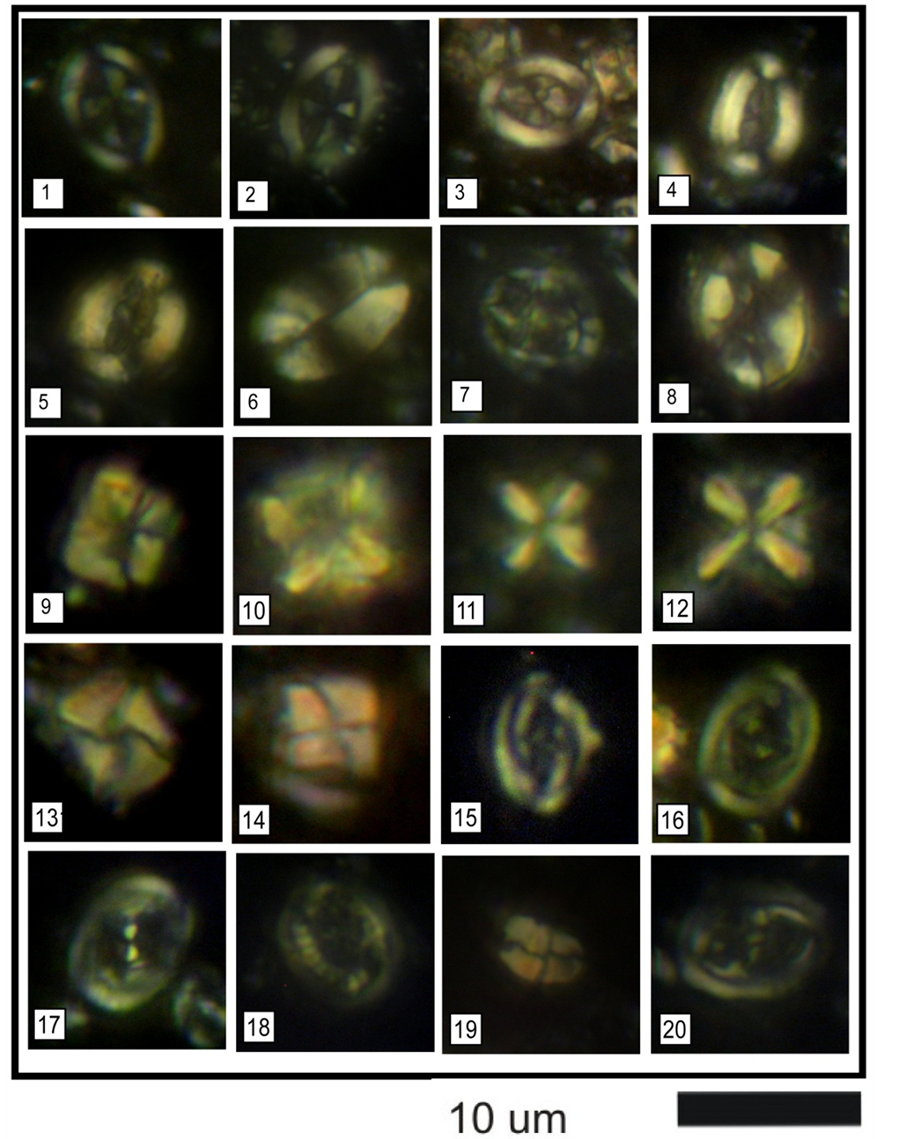
Plate 1. All figures ×1250. 1-3. Arkhangelskiella cymbiformis Vekshina, 1—sample no. 1, 2—sample no. 28, 3— sample no. 38. 4, 5. Aspidolithus parcus (Stradner), 4—sample no. 46, 5—sample no. 53. 6. Prolatipatella multicarinata (Gartner), sample no. 26. 7. Prediscosphaera cretacea (Arkhangelsky), sample no. 25. 8. Eiffellithus turriseiffelii (Deflandre in Deflandre & Fert), sample no. 24. 9, 13, 14. Micula murus (Martini), 9—sample no. 51, 13—sample no. 54, 14—sample no. 57. 10-12. Micula decussata Vekshina, 10—sample no. 8, 11—sample no. 13, 12—sample no. 22. 15, 20. Placozygus sigmoides (Bramlette & Sullivan), 15—sample no. 65, 20—sample no. 71. 16, 17. Reinhardtites anthophorus (Deflandre), 16—sample no. 6, 17—sample no. 14. 18. Cribrosphaerella ehrenbergii (Arkhangelsky), sample no. 2. 19. Calculites obscures (Deflandre), sample no. 15.
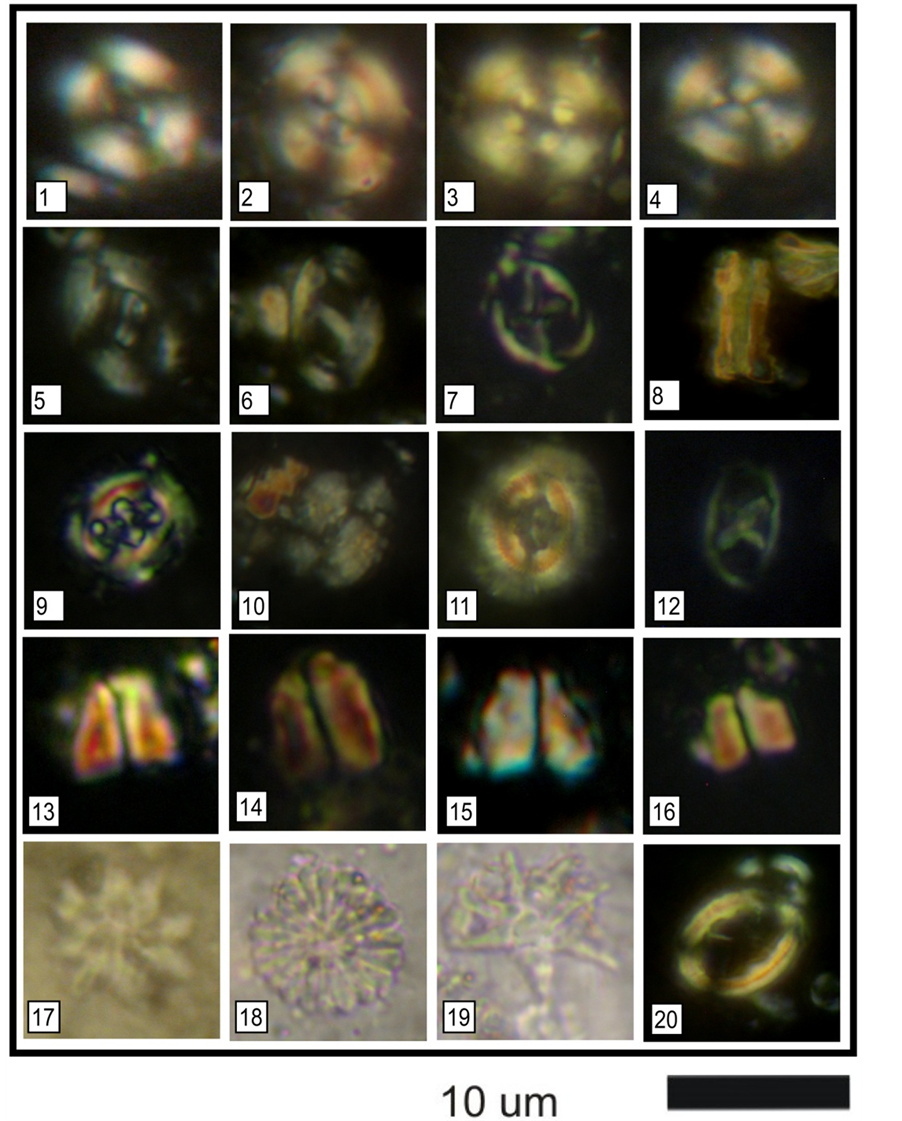
Plate 2. All figures ×1250. 1-3, 4. Watznaueria barnesae (Black in Black & Barnes), 1—sample no. 11, 2—sample no. 36, 3—sample no. 39, 4—sample no. 40. 5-6. Zygodiscus plectopons (Bramlette & Sullivan), 5—sample no. 75, 6—sample no. 80. 7. Neococcolithes protenus (Bramlette & Sullivan), sample no. 92. 8. Lucianorhabdus cayeuxii Deflandre, sample no. 29. 9. Chiasmolithus danicus (Brotzen), sample no. 76. 10. Ellipsolithus macellus (Bramlette & Sullivan), sample no. 94. 11. Ericsonia formosa (Kamptner), sample no. 113. 12. Neococcolithes dubius (Deflandre), sample no. 114. 13, 15. Fasciculithus clinatus Bukry, 13—sample no. 83, 15—sample no. 85. 14-16. Fasciculithus tympaniformis (Hay & Mohler), 14—sample no. 78, 16—sample no 81. 17. Discoaster barbadiensis Tan, sample no. 87. 18. Discoaster multiradiatus Bramlette & Reidel, sample no. 86. 19. Discoaster araneus Bukry, sample no. 88. 20. Chiasmolithus solitus (Bramlette & Sullivan), sample no. 118.
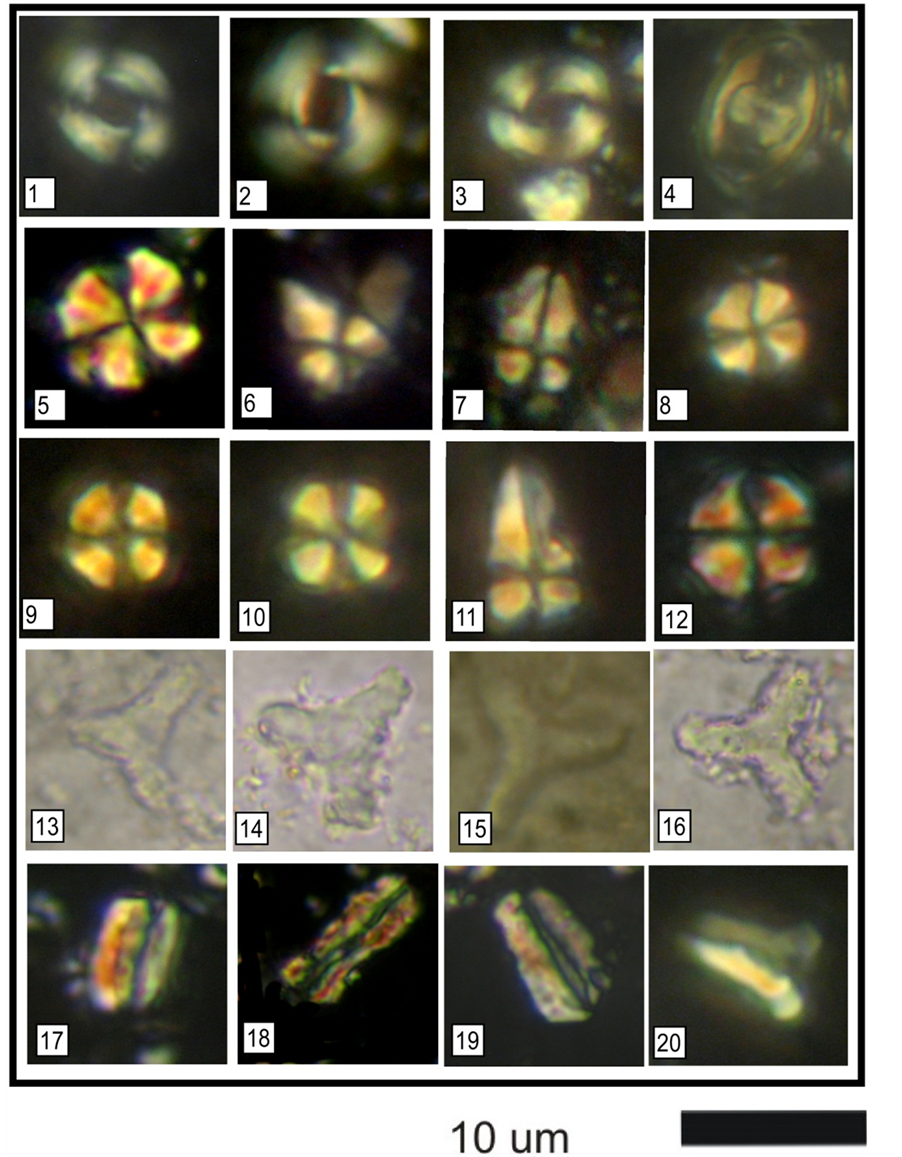
Plate 3. All figures ×1250. 1, 3. Reticulofenestra dictyoda (Deflandre), 1—sample no. 109, 3—sample no 113. 2. Reticulofenestra umbilica (Levin), sample no. 102, 4—Zeugrhabdotus pseudanthophorus (Bramlette & Martini), sample no. 46. 5, 8, 9, 10, 12. Sphenolithus moriformis (Bronnimann & Stradner), 5—sample no. 91, 8—sample no. 101, 9—sample no. 105, 10—sample no. 106, 12—sample no. 113. 6. Sphenolithus obtusus Bukry, sample no. 118. 7, 11. Sphenolithus radians Deflandre, 7—sample no. 97, 11—sample no. 99. 13-16. Tribrachiatus orthostylus Shamrai, 13—sample no. 102, 14—sample no. 105, 15—sample no. 106, 16—sample no. 108. 17-20. Zygrahablithus bijugatus (Deflandre), 17—sample no. 87, 18—sample no. 90, 19—sample no. 93.


